MySQL Learning Series 4: Operators
There are many operators in MYSQL. This section mainly talks about the operators that are in MYSQL but not in SQLSERVER
Safe equal operator ()
This The operator performs the same comparison as the = operator, but can be used to determine NULL values.
When both operands are NULL, the return value is 1 instead of NULL;
When one operand is NULL, the return value is 0 instead of NULL .
The following are the execution results of SELECT NULL 1 SELECT 10 SELECT NULL NULL
When both operands are NULL , its return value is 1 and not NULL;

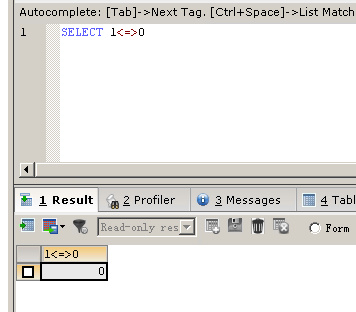

The syntax format is: LEAST (value 1, value 2,...value n), where the value n indicates that there are n values in the parameter list. In the case of two or more arguments, returns the minimum value.
If any independent variable is NULL, the return value of LEAST() is NULL
Use the LEAST operator to determine the size. The SQL statement is as follows:
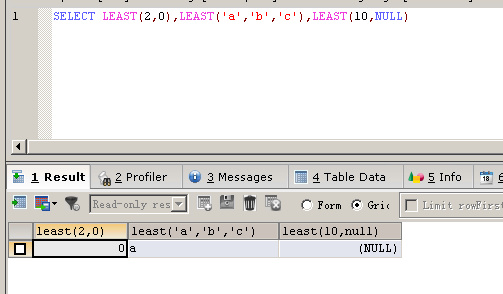
When the parameter is a string, the alphabetical order will be returned in the highest order characters;
When there is NULL in the comparison value list, the size cannot be determined, and the return value is NULL
GREATEST operator
The syntax format is: GREATEST(value 1, value2,...valuen), where n means there are n values in the parameter list.
In the case of two or more parameters, return the maximum value.
If any independent variable is NULL, the return value of GREATEST() is NULL
Use the GREATEST operator to determine the size. The SQL statement is as follows:

When the parameter is a string, the lowest order of letters will be returned. characters;
When there is NULL in the comparison value list, the size cannot be determined, and the return value is NULL
REGEXP operator
There is no regular function or operation in SQLSERVER MYSQL is indeed relatively complete in this regard.
is used to match strings. The syntax format is: expr REGEXP matching conditions. If expr meets the matching conditions, 1 is returned;
If it does not meet, then returns 0;
If either expr or the matching condition is NULL, the result is NULL
Several commonly used wildcard characters:
(1) '^' matches A string that begins with the character after this character
(2) '$' matches a string that ends with the character after this character
(3) '.' matches any single character
(4) '[...]' matches any characters within square brackets. For example, "[abc]" matches a, b, or c.
The range of characters can use a '-', "[a-z]" matches any letter, and "[0-9]" matches any number
(5) '*' matches zero one or more characters preceding it. For example, "x*" matches any number of '*' characters, "[0-9]*" matches any number of digits,
and ".*" matches any number of any characters.
Use the REGEXP operator to perform string matching operations. The SQL statement is as follows:
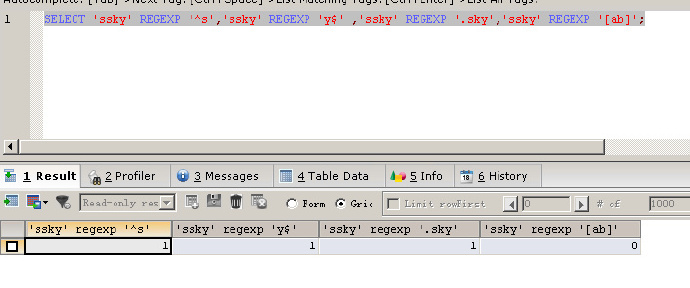
'^s' means matching any string starting with the letter s, so the matching condition is met and 1 is returned;
'y$' means matching any string ending with the letter y, Therefore, the matching condition is met and 1 is returned;
'.sky' means that it matches any string ending with sky and the character length is 4, so the matching condition is met and 1 is returned;
'^s ' means matching any string starting with the letter s, so the matching condition is met and 1 is returned;
'[ab]' means matching any string containing the letter a or b, and there is no letter a in the specified string There is no letter b, so the matching condition is not met and 0 is returned;
TIPS: Regular expressions are a powerful tool for complex queries. Compared with LIKE string matching, they can use more wildcard types.
Query results are more flexible.
Logical operator
Logical AND operator: AND or &&
Logical OR operator: OR or ||
The above two operators are Not to mention
In SQLSERVER, the AND operator is AND or &; the OR operator is OR or |
http://sqlfool.com/2009/02/bitwise-operations/
Exclusive OR operator: , the return result is 0;
If one is 0 and the other is non-0, the return result is 1
Use the exclusive OR operator XOR for logical judgment, the SQL statement is as follows
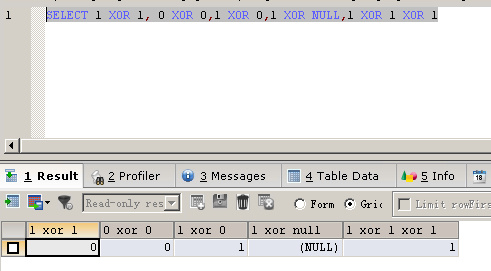 You can see from the results that the operands on both sides of the operators in '1 XOR 1' and '0 XOR 0' are both non-zero values, or both are zero values, so Returns 0;
You can see from the results that the operands on both sides of the operators in '1 XOR 1' and '0 XOR 0' are both non-zero values, or both are zero values, so Returns 0;
'1 XOR 0′ has two operands, one is 0 and the other is non-0, and the return result is 1;
'1 XOR NULL' has One operand is NULL, and the return result is NULL;
'1 XOR 1 XOR 1' has multiple operands, and the operators are the same, so the operators are calculated from left to right, '1 XOR 1' The result is 0, and then XOR operation is performed with 1, so the result is 1.
TIPS: The calculation of a Used, here is just a brief introduction
Bit operators are used to test, shift or test bits in binary bytes
The bit operations provided in MYSQL are
Bitwise OR (|)
Bitwise AND (&)
Bitwise XOR (^)
Bitwise left shift (
Bitwise right shift (>>)
Bitwise inversion (~): Invert all bits
TIPS: You can use BIN()=binary The function checks the binary representation of a decimal number
For example, the number 20 SELECT BIN(20)
The binary representation is: 10100
Similarly SQLServer also has bit operators, but not as many as MySQL, as follows

 The following special characters need to be preceded by a backslash when entering
The following special characters need to be preceded by a backslash when entering
Inputting single quotes requires: \'
Inputting double quotes requires:\”
Enter backslash: \\
Enter carriage return: \r
Enter newline: \n
Enter tab: \tab
Enter the backspace character:\b
Be sure to escape these special characters before inserting them into the database
In SQLSERVER, these special characters are not preceded by a backslash\ , but add single quotes '
For example, insert a single quote, add a backslash, and the insertion is successful
Summary
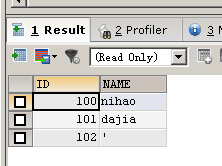 The above is the content of MySQL Learning Series 4: Operators. For more related content, please pay attention to the PHP Chinese website ( www.php.cn)!
The above is the content of MySQL Learning Series 4: Operators. For more related content, please pay attention to the PHP Chinese website ( www.php.cn)!
##

Hot AI Tools

Undresser.AI Undress
AI-powered app for creating realistic nude photos

AI Clothes Remover
Online AI tool for removing clothes from photos.

Undress AI Tool
Undress images for free

Clothoff.io
AI clothes remover

AI Hentai Generator
Generate AI Hentai for free.

Hot Article

Hot Tools

Notepad++7.3.1
Easy-to-use and free code editor

SublimeText3 Chinese version
Chinese version, very easy to use

Zend Studio 13.0.1
Powerful PHP integrated development environment

Dreamweaver CS6
Visual web development tools

SublimeText3 Mac version
God-level code editing software (SublimeText3)

Hot Topics
 1378
1378
 52
52
 MySQL: Simple Concepts for Easy Learning
Apr 10, 2025 am 09:29 AM
MySQL: Simple Concepts for Easy Learning
Apr 10, 2025 am 09:29 AM
MySQL is an open source relational database management system. 1) Create database and tables: Use the CREATEDATABASE and CREATETABLE commands. 2) Basic operations: INSERT, UPDATE, DELETE and SELECT. 3) Advanced operations: JOIN, subquery and transaction processing. 4) Debugging skills: Check syntax, data type and permissions. 5) Optimization suggestions: Use indexes, avoid SELECT* and use transactions.
 How to open phpmyadmin
Apr 10, 2025 pm 10:51 PM
How to open phpmyadmin
Apr 10, 2025 pm 10:51 PM
You can open phpMyAdmin through the following steps: 1. Log in to the website control panel; 2. Find and click the phpMyAdmin icon; 3. Enter MySQL credentials; 4. Click "Login".
 How to create navicat premium
Apr 09, 2025 am 07:09 AM
How to create navicat premium
Apr 09, 2025 am 07:09 AM
Create a database using Navicat Premium: Connect to the database server and enter the connection parameters. Right-click on the server and select Create Database. Enter the name of the new database and the specified character set and collation. Connect to the new database and create the table in the Object Browser. Right-click on the table and select Insert Data to insert the data.
 MySQL and SQL: Essential Skills for Developers
Apr 10, 2025 am 09:30 AM
MySQL and SQL: Essential Skills for Developers
Apr 10, 2025 am 09:30 AM
MySQL and SQL are essential skills for developers. 1.MySQL is an open source relational database management system, and SQL is the standard language used to manage and operate databases. 2.MySQL supports multiple storage engines through efficient data storage and retrieval functions, and SQL completes complex data operations through simple statements. 3. Examples of usage include basic queries and advanced queries, such as filtering and sorting by condition. 4. Common errors include syntax errors and performance issues, which can be optimized by checking SQL statements and using EXPLAIN commands. 5. Performance optimization techniques include using indexes, avoiding full table scanning, optimizing JOIN operations and improving code readability.
 How to create a new connection to mysql in navicat
Apr 09, 2025 am 07:21 AM
How to create a new connection to mysql in navicat
Apr 09, 2025 am 07:21 AM
You can create a new MySQL connection in Navicat by following the steps: Open the application and select New Connection (Ctrl N). Select "MySQL" as the connection type. Enter the hostname/IP address, port, username, and password. (Optional) Configure advanced options. Save the connection and enter the connection name.
 How to recover data after SQL deletes rows
Apr 09, 2025 pm 12:21 PM
How to recover data after SQL deletes rows
Apr 09, 2025 pm 12:21 PM
Recovering deleted rows directly from the database is usually impossible unless there is a backup or transaction rollback mechanism. Key point: Transaction rollback: Execute ROLLBACK before the transaction is committed to recover data. Backup: Regular backup of the database can be used to quickly restore data. Database snapshot: You can create a read-only copy of the database and restore the data after the data is deleted accidentally. Use DELETE statement with caution: Check the conditions carefully to avoid accidentally deleting data. Use the WHERE clause: explicitly specify the data to be deleted. Use the test environment: Test before performing a DELETE operation.
 How to use single threaded redis
Apr 10, 2025 pm 07:12 PM
How to use single threaded redis
Apr 10, 2025 pm 07:12 PM
Redis uses a single threaded architecture to provide high performance, simplicity, and consistency. It utilizes I/O multiplexing, event loops, non-blocking I/O, and shared memory to improve concurrency, but with limitations of concurrency limitations, single point of failure, and unsuitable for write-intensive workloads.
 MySQL: An Introduction to the World's Most Popular Database
Apr 12, 2025 am 12:18 AM
MySQL: An Introduction to the World's Most Popular Database
Apr 12, 2025 am 12:18 AM
MySQL is an open source relational database management system, mainly used to store and retrieve data quickly and reliably. Its working principle includes client requests, query resolution, execution of queries and return results. Examples of usage include creating tables, inserting and querying data, and advanced features such as JOIN operations. Common errors involve SQL syntax, data types, and permissions, and optimization suggestions include the use of indexes, optimized queries, and partitioning of tables.




